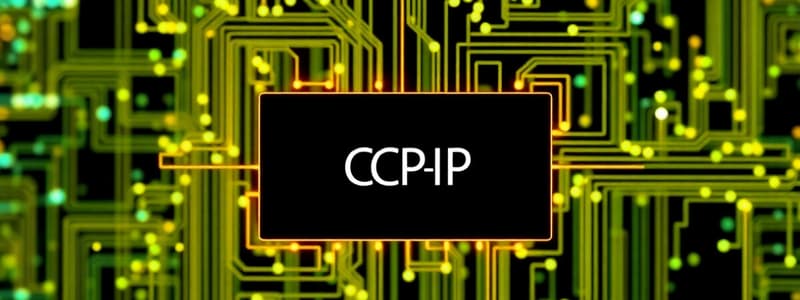Podcast
Questions and Answers
What is the primary purpose of the OSI model?
What is the primary purpose of the OSI model?
The TCP/IP model consists of five layers.
The TCP/IP model consists of five layers.
False
What organization developed the OSI model?
What organization developed the OSI model?
International Organization for Standardization (ISO)
The ________ Layer of the OSI model is responsible for data routing and addressing.
The ________ Layer of the OSI model is responsible for data routing and addressing.
Signup and view all the answers
Match the following layers with their functions in the OSI model:
Match the following layers with their functions in the OSI model:
Signup and view all the answers
Which layer of the TCP/IP model is focused on user interfaces and higher-level protocols?
Which layer of the TCP/IP model is focused on user interfaces and higher-level protocols?
Signup and view all the answers
The Physical Layer of the OSI model translates and encrypts data.
The Physical Layer of the OSI model translates and encrypts data.
Signup and view all the answers
Name one of the layers in the TCP/IP model.
Name one of the layers in the TCP/IP model.
Signup and view all the answers
Study Notes
TCP/IP and OSI Model Introduction
- The TCP/IP and OSI models are crucial for understanding network communication
- The OSI model, developed by the International Organization for Standardization (ISO), is a conceptual framework for standardizing network functionalities
- The OSI model consists of seven layers: Application, Presentation, Session, Transport, Network, Data Link, and Physical
- The Application layer handles user applications
- The Presentation layer translates and encrypts data for the application layer
- The Session layer manages sessions and dialogues between applications
- The Transport layer ensures reliable data transfer
- The Network layer routes data, handles addressing, and forwards packets
- The Data Link layer manages node-to-node data transfer and error detection
- The Physical layer handles the physical connection and raw data transmission
- The OSI model serves as a universal guideline for network interoperability
- The TCP/IP model, developed by the U.S. Department of Defense (DoD), has four layers: Application, Transport, Internet, and Network Interface
- The Application layer in TCP/IP focuses on user interfaces and higher-level protocols
- The Transport layer manages end-to-end communication and data transfer
- The Internet layer handles routing and addressing of data packets
- The Network Interface layer focuses on network interfaces for data exchange
TCP Connection Observation using Wireshark
- A TCP (Transmission Control Protocol) connection, at the transport layer, follows steps:
- A three-way handshake (SYN-SYN-ACK-ACK) establishes the connection
- Data transmission occurs in segments, acknowledged by the receiving device
- Wireshark is a network protocol analyzer, used to capture, inspect, and analyze network traffic in real-time.
Studying That Suits You
Use AI to generate personalized quizzes and flashcards to suit your learning preferences.
Related Documents
Description
Explore the fundamental concepts of the TCP/IP and OSI models in this quiz. Understand the seven layers of the OSI model and their roles in network communication. Learn how these models facilitate interoperability in network systems.




